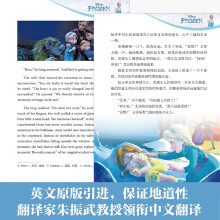田间之旅Field Trip
我读的第一所学校坐落在一座小荒山的山顶,校舍是一间平房,屋顶上插了一个风向标。校舍的周围是农田(农田里还有一个牲畜棚,用来养家畜),当时那片地方还不属于伊利诺伊州的乌尔班纳。回想起来,那所学校有6个班级,共有35名学生,大部分是一些年龄较小的孩子,当然也有十二三岁的。
1953年,父亲在伊利诺伊大学读哲学博士,6岁的我在上一年级。我的同学和高年级学生中的大部分都是农民出身的孩子,有的是享受《美国退伍军人法案》福利的士兵大学生的子女,有的是因为家里太穷无法在城市生活并享受那里的教育。至于我,早期教育主要是父母在家给予的,不会有太大的影响。
学校里只有一名教师——柯耐普夫人。柯耐普夫人是一名职业教师,她与学校的建筑物看起来一样古老。柯耐普夫人说,她从事了一辈子教育工作,我猜想,她那时应该已经做了35~40年的教育工作了。柯耐普夫人的头发已经全白了,但梳理得很整齐,我想她大概已经六十多岁了。
柯耐普夫人在教学上因材施教,而且对于这种方法已经很有经验了。对于已经能够欣赏史蒂文森和鲍勃先生的诗歌的学生,还有那些读《狄克和珍妮的故事》有些困难的学生,她都能进行指导。假如把一个年级看成是一个不同的国家,那么柯耐普夫人就是一个能流利地讲六种语言的人。不论是学习上,还是在其他方面,柯耐普夫人总能找到适当而又令人好奇的话题。比如说,她所知道的棒球和棒球历史的知识就要比我的父亲多得多,而且总是很乐意与你讨论棒球游击手皮?维?雷斯相对于奇科?卡拉斯科尔的优点,其中雷斯是她最喜欢的选手,而卡拉斯科尔是我最喜欢的选手。
柯耐普夫人在我的记忆中留下了一件终身难忘的事情,然而,这件事情不是发生在学校里,而是在乡村玉米田间的一条小路上。第一学年结束的那天下午,天气非常好,她带着我们去田野游玩,准确地说,那是一片种着玉米和小麦的农田,这些庄稼长得比我们还高,也比柯耐普夫人高。绿色的玉米和小麦秆已经变黄,但是还需要两三个月才能收割。
我们漫步于田间,柯耐普夫人耐心地给我们讲述着田间的每一只虫子、每一只小鸟以及每一片树叶。我们像大多数孩子一样,眼睛入迷地捕捉着她给我们讲述的一切。我们沿着那条铺着沙砾的土路走着,这是一条不通车的路,道路的宽度仅够一辆拖拉机或一辆小汽车通过,一路上看不到一棵树。伊利诺伊草原地势平坦,但我们只能看到地平线上蓝色的天空,偶尔也能看到庄稼地尽头露出的农舍屋顶。我们停下来,在路边吃午餐——三明治,耳边传来风吹过庄稼发出的沙沙声,还有乌鸦、蟋蟀和甲虫发出的叫声,眼前是随风摇摆的庄稼。
我们在吃过午餐后继续向前走,然而眼前只是一片又一片的庄稼,耳边是一阵又一阵的鸟叫声,就像是重复前面的旅行,我和其他人一样,开始失去耐心。就在那时,奇迹出现了,在几百码外的另一条田间小路的一侧,坐落着一家冰淇淋店(几年以后,我想起来就感觉那是从《城市贫民区》或者史蒂芬?金的小说里突然冒出来的一样)。这家小店只是一个6~8英尺长、2英尺宽、5英尺高的木柜台,柜台上醒目地印着“冰淇淋——10种口味”,柜台上是一个由几根杆子支起来的遮阳用的木板。一个头发斑白的中年男子面带笑容地站在柜台后面。
柯耐普夫人与这名男子互相打了招呼,就像老朋友一样。然后,她转身对我们说,她请客,每个人要一个任何口味的冰淇淋。大家一下子变得兴高采烈。曾经吃过的巧克力和香草口味的冰淇淋,味道不错,大家商量着是要吃过的,还是尝尝外来的罗克杰或蓝莓冰淇淋。最后,每个人挑选了自己想吃的口味,那个中年男人给我们每人都挖了一大勺。大家一边享受着冰淇淋的香味,一边大口地吃起来。
然后,那个男人问柯耐普夫人:“您想要什么口味的?”我记得,他说话的时候眼睛眨了一下,随后两个人就客套起来。即使几年前与柯耐普夫人来过这个地方的那些学生,也不知道这个冰淇淋店。
柯耐普夫人想了一下,说:“每个口味来一勺,都装在一个盒子里吧。”
……
My first school was the storied one-room schoolhouse. An old white washed building with a red roof and a vane on the peak, it sat at the top of an unpaved hill surrounded by farmland.including a barn rife with livestock.in a then-unin-corporated area of Urbana, Ilinois. The school housed all six primary grades and, as I recall, there were about thirty-five of us, mostly very young, although we ranged in age, of course, up to twelve or thirteen.
The year was 1953, and I was six years old, a first grader, and the son of a Ph. D. student at the University of Ilinois. My peers and the upper graders were farm kids or children of undergrads taking advantage of the GI Bill. Some were just too poor to live in the city, which would have qualified them for a city school. I suspect my parents dismissed the relevance of first grade, since most of my education came at home, at their hands, anyway.
The sole teacher in that school was as classic as the building itself. Mrs. Knapp was a schoolmarm by profession and she’d been doing it, she said, all her life. By then, I’d guess, that meant thirty-five or forty years on the job. She had to have been in her sixties:white hair in perfect array.
She handled our diverse intellects with perfect aplomb, guiding those of us who could read well through the pleasures of Stevenson’s poetry and Mr. Popper and those who struggled with reading through the joys of Dick and Jane. If every grade was a different country, Mrs. Knapp was fluent in the six languages we spoke, always having appropriate conversation to offer on whatever subject—academic and not—that our curiosity was heir to. She knew, for example, more about baseball and its history than my father did and was always ready to argue the merits of Pee Wee Reese (her favorite shortstop) against Chico Carrasquel (mine).
The one Mrs. Knapp incident that will always remain engraved in my memory didn’t happen at school, however. It happened on a deserted country road that divided corn-fields on the afternoon of the last day of that, my first full-fledged school year. To celebrate the beautiful weather, she’d taken us on a field trip, literally, through the bright yellow and green of corn and wheat stalks that were taller than I was (and than she was, too) but still two or three months shy of their harvest.
We wandered, as large groups of children are wont to do, our eyes catching with fascination on every bug and bird and leaf, every one of which, unfailingly, Mrs. Knapp had explanations for. We trekked along utterly untrafficked gravel and dirt roads that had been bulldozed just wide enough for tractors or a single car to travel. There were no trees: The Ilinois prairie land was flat, and we could see only the blue of the horizon and an occasional farmhouse rooftop beyond the fields of grain. We ate our lunch sandwiches along a roadside, listening to the rustle of the wind through the gently waving crops, the cries of the crows, the chirrs of the crickets and beetles.
After lunch we walked more. Now, though, the trip had become repetitious—more fields, more crops, more birdcalls—and I, certainly among others, was becoming impatient. Then, it happened: There, in the absolute middle of nowhere(straight out of what, some years later, I would think of as The Twilight Zone or a Stephen King novel), on the side of another single-lane road hundreds of yards from anything that resembled civilization, stood an ice cream stand. Nothing fancy, just a wooden counter six or eight feet wide, five feet high, two feet deep, with poles supporting a wood sheet that served as sun cover for the grizzled, but smiling, middle-aged man who stood behind it. The words“Ice Cream—10 Flavors” were painted prominently on the front.
The man and Mrs. Knapp greeted each other as old friends. She turned to us and said each of us could have an ice cream cone, any flavor we wished, her treat. Our enthusiasm was, naturally, boundless, and debate over whether to stick to the known delights of chocolate or vanilla or whether to experiment with the exotic Rocky Road or Blueberry raged among us. But we each settled on something, and the man scooped large scoops into waffle cones and handed them out. We savored and devoured.
Then he asked Mrs. Knapp, “ What would you like? ” I like to think there was a twinkle in his eyes as he did and that what followed was a ritual between them, although the few kids who’d attended Mrs. Knapp’s classes in years before hadn’t been to the stand.
She paused thoughtfully, then said, “ I think I’ll have a cone with a scoop of each.”
……
展开










